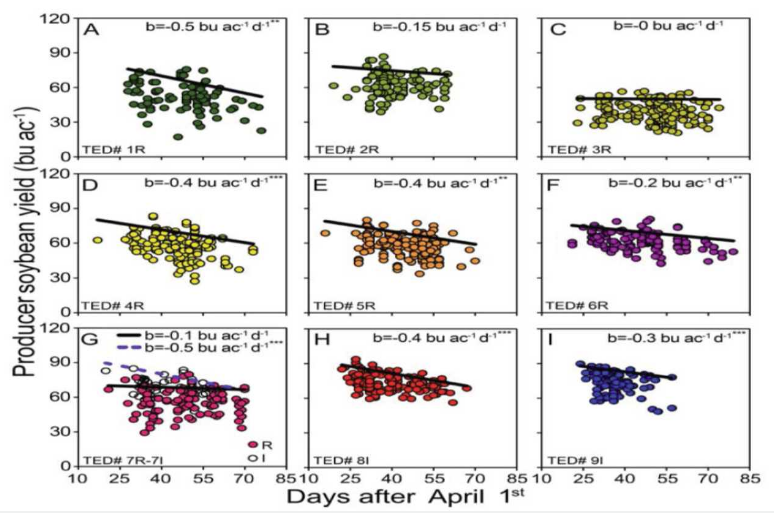Soybean planting date is absolutely critical to maximize yield (in most years and environments). Over the past few years, we’ve participated in a North Central Soybean Research Program (NCSRP) funded project with the goal of identifying causes of the “soybean yield gap.” (What factors are reducing soybean yield?) Across the Midwest, planting date was the most consistent management factor that influenced soybean yield.
Figure 1 shows the relationship between soybean yield and planting date (Panel A = primarily northern Ohio excluding northwest Ohio; Panel B = primarily central and southern Ohio). In northern Ohio, soybean yield was reduced by 0.5 bushel/acre/day for every day planted after the end of April. In central/southern Ohio, soybean yield was reduced by 0.15 bushel/acre/day for every day planted after the end of April. For additional information on this project, see https://stepupsoy.osu.edu/soybean-production/soybean-yield-gap-research.
Figure 1. Producer soybean yield plotted against planting date in nine environments. (Ohio consists of primarily environment A and B.)

Small plot research conducted in Ohio shows a similar relationship (Figure 2). In Clark County (WARS location), soybean yield was reduced 0.6 bushel/acre/day for each day planted after the initial planting date. However, in Wood County (NWARS), soybean yield was the same regardless of planting date. Planting date is important and usually influences soybean yield, but not necessarily in every environment and year. For more information on this research see: https://stepupsoy.osu.edu/soybean-production/soybean-fertility-0/starter-fertilizer
Timely planting is important for canopy closure which increases light interception, improves weed control, and helps retain soil moisture.

Figure 2. Effect of soybean planting date on soybean grain yield at the Western Agricultural Research Station (WARS) in 2013 and 2014 and the Northwest Agricultural Research Station (NWARS) in 2014.
In both datasets, you’ll notice the first planting date is end of April/early May. We do not have any data for planting soybeans in February or March. In our research, soil temperature was at least 50°F at planting. Planting too early (before field conditions are adequate) is risky. Factors such as damping-off and pressure from bean leaf beetle are concerns to keep in mind, as well as the possibility of a late spring frost. (Our early May planted soybeans in Wayne County in 2013 were damaged by bean leaf beetle and two frosts in mid-May.)





